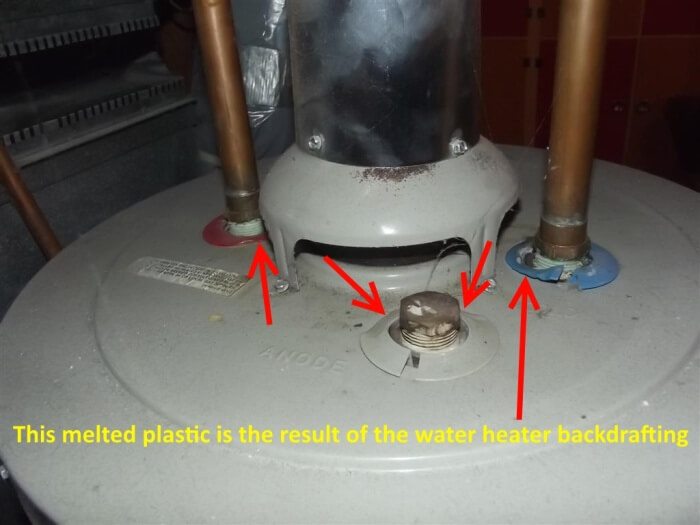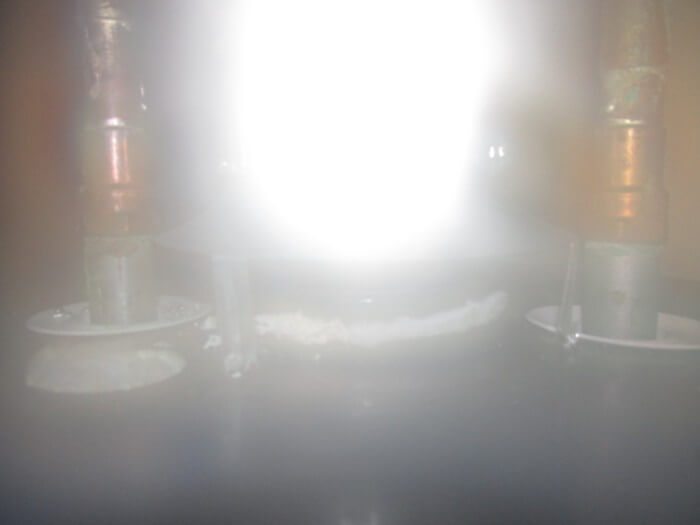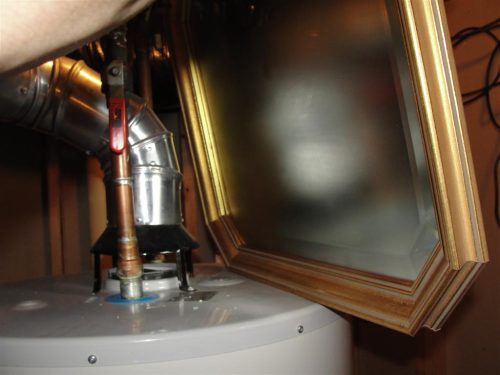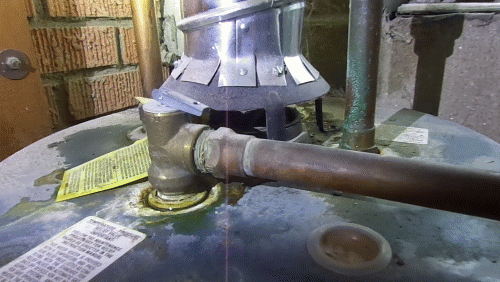When a home inspector identifies backdrafting at a water heater, what steps should be taken to address it? It depends.
Was it really backdrafting?
First, you need to find out if the home inspector identified backdrafting or signs of backdrafting. These are two very different things. The most notorious sign of backdrafting is melted plastic at the draft hood. Water heaters come with small plastic sleeves at the water lines, and they will easily melt and deform when a water heater backdrafts.
Note how the melting only occurs on the sides that face the draft hood; this is a dead giveaway that water heater backdrafting caused the melting. But to be clear, this is not proof that the water heater was backdrafting during the home inspection. It’s only evidence that the water heater backdrafted at some point in its life.
When a home inspector finds this, they should say there were signs of previous backdrafting, but not that the water heater backdrafts. A home inspector should not say a water heater backdrafts… unless it backdrafts! That melting could have occurred a long time ago, and the cause of the melting may have already been fixed.
Definitive Evidence
A great way for a home inspector to get visual evidence of a water heater backdrafting is to hold their camera close to the draft hood so their camera lens fogs over. The photo will look like this:
Or the home inspector could hold a mirror up to the draft hood and let it fog up. I love that method. This is definitive evidence that the water heater backdrafts. The mirror pictured below is comically oversized, but you get the point.
Also, a video that shows air pushing out of the draft hood is definitive evidence. Even better yet, if the camera lens fogs up and the water line is covered in condensation.
So now that I’ve made a clear distinction between backdrafting and signs of backdrafting, let’s talk about next steps.
What to do about signs of backdrafting
When a home inspector finds signs of previous backdrafting, they can recommend having a second person inspect the situation further… or inspect it themselves and make a call based on their professional experience, assuming they’re qualified. Everyone on my team at Structure Tech falls into the second camp.
If a second person is called in to inspect the situation further, it will probably be a plumber or an HVAC contractor. Some are qualified to perform this inspection, while others aren’t. If the person inspecting the water heater draft is qualified, they will create a worst-case scenario to test the draft. If you want to be sure that whoever is coming out to inspect the draft at the water heater is qualified, hire someone familiar with the Building Performance Institute’s (BPI) Combustion Safety Test Procedure For Vented Appliances.
As a home inspector, I don’t follow these standards exactly, but I understand them and I do most of the stuff on this list. We call this a worst-case scenario test. If the water heater doesn’t backdraft under these conditions, I have nothing to report. I’d mention there were signs of previous backdrafting, but I did a worst-case scenario test and the water heater drafted properly, so nothing needs to be done. End of story.
What to do about backdrafting
If a home inspector finds backdrafting, they should document it, provide proof, and recommend repair. What’s the repair? It depends on the cause. I covered many potential reasons for backdrafting in my blog post titled Water Heater Backdrafting, Part 2 of 2: Why It’s Happening and How To Fix It.
The most common cause of water heater backdrafting is insufficient combustion air. When you have a bunch of fans running at the same time, they’ll overpower the water heater exhaust and cause it to backdraft. If you open a window or an exterior door and the water heater stops backdrafting, you have your answer right there.
If the next person who comes in behind the home inspector can’t get the water heater to backdraft, my advice is to contact a different professional. Contact someone who has a better understanding of building science and is familiar with BPI’s safety standards for combustion testing.




